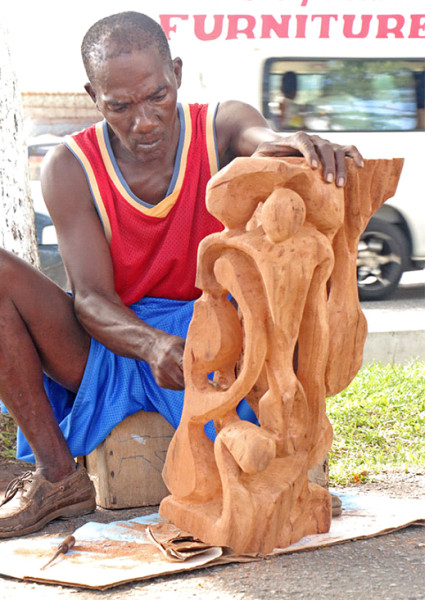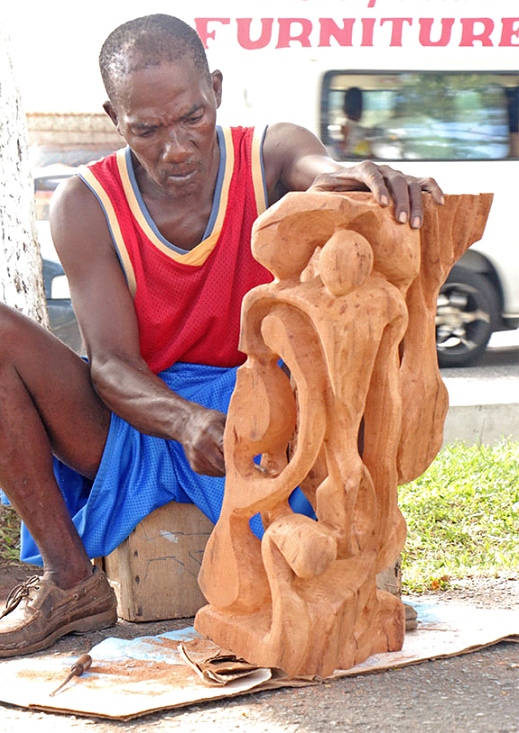
The question of cultural industries, or creative industries as some prefer to call it, is very much with us in Guyana and the Caribbean. Even nomenclature is an issue. Some protagonists across the Caribbean have taken a political position on it, preferring to say “creative industries” which they feel defines what it is. They avoid “cultural industries” because they say that is the term used by governments who do not care and do not do enough for the industries, but like to call the name. Main Street Art Group and its exhibition remind us of the unfinished cultural industries issue.
This group, founded in the 1980s, represents a long-standing collection of artists and artisans who have always been outside of the mainstream of art in Guyana. They started out as working class individuals creating and selling their products in the avenue along Main Street in Central Georgetown. They were there probably because that is a former hotel area – especially outside of the Hotel Tower. Here they would get the attention of visitors and a likely market for artwork, souvenirs, ornaments and ‘tourist art’.

That is very much like the situation in Haiti, where several artists are found in Port Au Prince outside large hotels and at various places on the roadside where they target visitors with an eye for the famed traditional (and cheap) Haitian art. A lot of it is commercial ‘tourist art’, but one can also find authentic work in which the local indigenous traditions in content, style and form are sometimes quite strong. The Haitian working class artists are skilled in that market, making urgent approaches to buyers and driving persuasive bargains.
Their Guyanese counterparts are not quite so aggressive. They are often at work on the sidewalk with chisel, hammer and wood, displaying and offering work for sale. These individuals grew in numbers over the years, always demanding greater recognition. Having formed themselves into an organised, formal association, they have been making statements about recognition, accommodation and entry into the mainstream art. Some years ago they did attempt an exhibition and were accommodated inside the mainstream National Gallery of Art at Castellani House. But the street is their gallery and they exhibit daily. Since then they have been accommodated by Guyana as privately sponsored but officially accredited artists in Carifesta VIII (2003) and Carifesta XI (2013) in Surinam, and again at Carifesta XII in Haiti (2015).
By now they have a distinct branded identity. They are workers in the field of cultural industries because they earn a living from their art. It is their income in a very serious ‘bread and butter’ way, unlike many of the leading mainstream artists who have regular jobs and will sell high priced pieces of art from time to time.
From the inception, sculpture has been the main standard bearer of the Main Street artists. It has been most visible and dominant among their work. It was their original preoccupation, with many of them seeing themselves as traditional wood carvers, or close to it. Some style themselves that way and some will imitate their notion of African art. But many others want to be accepted as original Guyanese artists. There is a range of work: paintings, leather craft, jewellery, accessories, and utility items for normal and ornamental uses. Many have moved from artisan to artist in the tradition of creating items for general personal or household use. They reflect a tradition in which utility items were works of art and vice versa.
In last month’s exhibition, the largest, most diverse and rich collection was the show of this kind of work. There was a very colourful assortment of handmade goods for use or wear. These included jewellery and accessories made from local material; leather craft including decorated footwear: sandals and slippers; bags, wallets, document holders, belts, chains, bracelets, earrings and jars. They looked as good as what is on the conventional market for those items and what is sold in stores up-market. What is better, these were hand-made, which ought to carry up both price and value. They surely looked better than much of the fashionably worn cosmetic and paste jewellery.
In the ‘Jubilee Art’ show, sculpture was the staple. Wood carvings were dominant and the most numerous. The commercial variety was quite common among the pieces and accounted for most of the pieces. Many were not traditional – they were realistic pieces often with the commercial market in mind. They depicted everyday life and occupations such as farmers, porkknockers, drummers and many birds – several of them eagles – and others. A few that stood out included ‘Black Cacique,’ which was impressive, as well as ‘Mother and Children’ along with ‘Duppy Conqueror.’ They were of the finely carved, polished, realistic or ultra-realistic variety.
However, a number of them were abstract. These demonstrated an interest among the artists in creating and even experimenting with works of art rather than commodities. Outstanding pieces among them were ‘Spirit of Light,’ which was particularly striking, ‘Old House,’ an imaginative piece, and ‘Nursing’.
Others demanding attention included ‘Day Before Harvest,’ one of the many quite small pieces; Land Sea Air, which suggested what the artists were doing with forms of abstraction and Glory. The artists proved that they were interested in exploring themes, forms, studies and even social commentary and a touch of folklore. But there were only a few very large sculptures in the show.
There was one outstanding set among the paintings, of which there was a fairly limited number in this exhibition. A suite of works on the masquerade tradition dominated all others on show. ‘Spirit of the Masquerade II’ led the way. It was followed by ‘Spirit of the Masquerade I’, with the recognisable motifs of the traditional dance form and ‘Spirit of the Masquerade III’ with bright colours on the same theme.
Those were all abstract works, which, as in the case of the sculpture, showed the artists’ readiness to advance the imagination apart from trying to produce work with commercial value. The worthy selections included ‘Masquerade,’ another on that theme – ‘Land of Our Birth’, alongside ‘River Side’ and ‘Fisher Man.’
Most of them, though, were the usual reproductions of popular scenes and landmark items. There were waterfalls, rivers, kokers and scenes and representations of recognisable Guyanese landscape. It was easy to find the usual roadside pieces although these were punctuated by those few with a bit more extension of the imagination.
Main Street Art Group takes itself seriously. It already has an identity, positioning itself among the culture of the people and commanding a public presence. The very formal registration and organisation of the group is a way of bringing it in line for wider appreciation. The exhibition ‘Jubilee Art’ gave public notice of a collective seeking admission to the academy of mainstream art, while underlining the right to earn a living.






